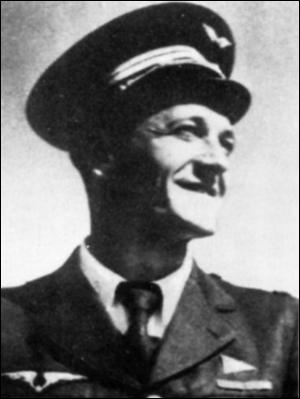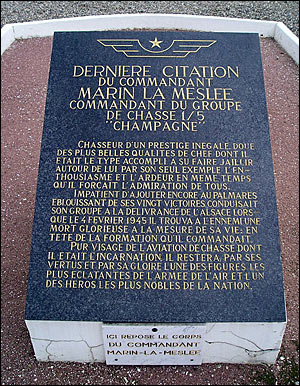Edmond Marin la Meslée

(Born 5 February 1912, Valenciennes – Died 4 February 1945, Dessenheim)
A child of the aviation age, the young Edmond inherited his passion for aircraft from his father, an engineer who graduated from the Arts et Métiers engineering school. Together they built gliders and formed air clubs. Graduating from high school in Latin and sciences at 16, he started a short-lived law course. After a few weeks, he applied for a pilot’s grant and was admitted into the aviation school in Morane. After earning his pilot’s licence on 1 August 1931, he completed his training in Istres on 20 April 1932 and started preparing for the entry exam to join the training school for reserve officers. Ranking a sub-lieutenant by 20 September, he gave up his stripes so he could bypass the regulation that banned reservist officers from flying. He then enlisted into a fighter unit at the rank of sergeant before joining the Air Force Academy in 1936 from where he graduated in October 1937 having returned to the rank of sub-lieutenant with a qualification in observation.
He was assigned to the GC I/5 fighter group in Reims and served under Jean Accart, in the first "Champagne" fighting squadron, which continued the legacy of the prestigious Spa-67 squadron from Navarre. Promoted to the grade of lieutenant at the start of the Second World War, his unit, flying one of the Curtis H-75 fighters, spent winter on the ground in Suippes, breaking up the daily monotony by carrying out long alert missions at altitude.
On 11 January 1940 Marin La Meslée, Marina as he was known over radio, experienced the intoxicating adrenalin of his first battles. On patrol with Lieutenant Rey, the two pilots brought a reconnaissance mission of a Dornier-17 to an end in the skies above Verdun. But it was in May of that year, confronted with the irresistible German machine of war that he earned his fame and entered into the aviation fighting hall of fame. On the 12th, he struck down two Stukas Junkers-87 and the following day more than one Messerschmitt-109 fighter plane. Over the following weeks Heinkel bomber, two Henschel-126s and one Heinkel-111 fell victim to his sharp shooting.
On 1 June, with 16 aircraft under his belt, he was appointed to lead the “Cigogne” squadron replacing Captain Accard, who had been seriously injured. When the Armistice was declared, he had carried out a total 106 sorties and chalked up fifteen victories in France and five over Germany, and earned ten Citations to the Order of the Army. His record is unrivalled.
In November 1942, the squadron based in North Africa received orders from Vichy to resume the offensive. Under cover of the British and American landing, the "Cigognes" flew for Free France in the skies above Tunisia, even if in reality the unit was only carrying out reconnaissance missions. The lieutenant carried out 105 sorties aboard an Airacobra P-39 and achieved four victories over the African coasts. A commander in June 1944, he returned to the base in Salon-en-Provence at the controls of a P-47 Thunderbolt on 20 September, a month after the landing in Provence. His unit was then attached to the 1st French Army.
In early 1945, offensives to reconquer Alsace were raging. Allied aircraft were used to destroy obstacles ahead of the infantry, attacking in perilous dives when necessary. On 4 February, Commander Edmond Marin la Meslée executed a second crossing over German lines. His aircraft, hit by a shot from a DCA, crashed and exploded two kilometres from the village of Rustenhardt.
His wings were permanently clipped just shy of his thirty-third birthday:
"A noble face of air-to-air combat, of which he was the embodiment,
He will forever remain for his virtues and his glory,
One of the most brilliant figures of the French Air Force
And one of the most noble heroes of the nation."

Mémorial de l'aviateur sur lieu de son crash. Source : Commune de Dessenheim

